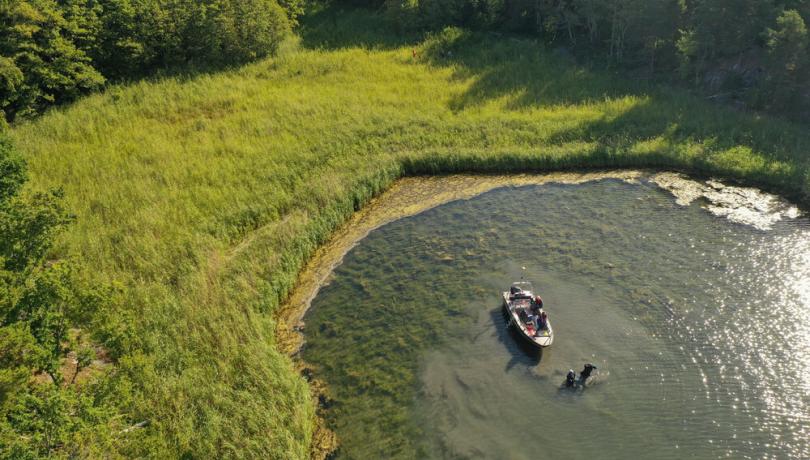In this "In Depth" section we talk about the TREC campaign, which aims to assess the impact of human activity on Europe's seas and coastal regions.

A good example of this is the scientific expedition TREC (TRaversing European Coastlines), which after making a stop in Bilbao last October now lands in Barcelona. Until April 2, the city of Barcelona will offer all those interested the opportunity to see the equipment and facilities that are part of an unprecedented campaign that, over two years, will travel the European coasts collecting information on their biodiversity and ecosystems.
Led by the European Molecular Biology Laboratory (EMBL), the Tara Océan Foundation, and the European Marine Biology Resource Centre (EMBRC), TREC also counts on the participation of national research institutes such as the Institut de Ciències del Mar (ICM-CSIC) of Barcelona, which participates both in the campaign and in the research activities of the European Molecular Biology Laboratory (EMBL), the Tara Océan Foundation and the European Marine Biology Resource Centre (EMBRC).
TREC also relies on the participation of national research institutes such as the Institut de Ciències del Mar (ICM-CSIC) in Barcelona, which participates in both research and outreach activities. In addition, the expedition is supported by other CSIC institutes such as the Institute of Evolutionary Biology (IBE: CSIC-UPF), the Institute of Environmental Diagnosis and Water Studies (IDAEA-CSIC) and the Center for Advanced Studies of Blanes (CEAB-CSIC).
In total, TREC brings together more than 150 research teams from more than 70 institutions from 29 European countries. The sampling work, which takes place in parallel on land, in the air, and at sea, ranges from microscopic organisms such as viruses or bacteria to all types of plants and larger animals. A journey through 22 European countries with stops at more than 120 sampling points will allow the scientific community to obtain a holistic picture of how marine ecosystems are affected and how they adapt to anthropogenic impact.
The role of the ICM in the campaign
The ICM participates in different projects within the framework of this campaign. At each stop, samples of sediments, aerosols, water, and micro- and macro-organisms are taken through the land-based mobile laboratories of the EMBL and the schooner Tara. In this way, the team aims to be able to carry out a census of biodiversity on land and in the sea, in addition to collecting a myriad of environmental data such as temperature, pH, salinity, or the presence of pollutants such as antibiotics and pesticides.
Specifically, the goal of the MSI team is to investigate coastal communities to track the impact of pollution, global warming, and ocean acidification. To do this, the scientists involved will take water samples to study biogeochemistry and analyze microbial plankton. In areas where the state of conservation permits, samples of benthic organisms, i.e. those living in contact with the seafloor, will also be collected.
"The TREC expedition offers an excellent opportunity to explore the connection between benthic and planktonic communities at the European level. The application of common methodologies will allow us to highlight the state of our coastal waters in terms of anthropogenic affectation, as well as their impact on emblematic organisms such as benthic filter feeders, macroalgae, and phanerogams. Since these organisms are highly affected by human activities, they represent a loss of functions for coastal ecosystems," states Marta Ribes, from the ICM-CSIC.
In addition, marine sediment cores will be recovered from which information from the last 100-200 years on the evolution of environmental conditions and the impact of contaminants on microbial communities will be extracted using ancient DNA.
"The possibility of combining climatic and environmental reconstructions with paleogenomic tools is an exceptional opportunity to explore how environmental changes shape microbial communities and how these are affected by current anthropogenic pressures," explains Eva Calvo, also from ICM-CSIC.
Finally, Ramiro Logares, another ICM-CSIC researcher involved in the project, notes that "the collection and analysis of standardized data along European coasts, across marine-terrestrial habitats and different time scales, will increase our knowledge of the anthropogenic impact and adaptations of various organisms to environmental challenges". In the researcher's opinion,
"This multidisciplinary effort will not only advance scientific knowledge, but will also inform conservation policies and sustainable management of natural resources, underscoring the importance of collaborative research in planetary biology."
In this regard, the pan-European nature of the project is noteworthy, which means that samples are taken in a standardized way, allowing the scientific community to compare and probe data across Europe in a way that has never been done before. In addition, thanks to the equipment and technologies of the mobile laboratories, it is possible to conduct research close to the sampling site, preventing samples from degrading and reducing changes from the original environment.
An opportunity to bring science to the general public
In addition to the Catalan scientific community, the TREC stop in Barcelona will offer the general public a unique opportunity to get a little closer to science. Between March 16 and 30, various outreach activities will be held on the Barceloneta Promenade and in the Port Vell that seek precisely this: to teach the public how science is done and encourage their commitment to address natural challenges and the impacts caused by mankind.
These include scientific workshops that include the sampling of soils, sediments, water, aerosols, selected species, and environmental data in which EMBL's mobile laboratories and the sailboat Tara participate. Through them, participants will have the opportunity to explore science for themselves and understand the links between land and sea, human beings, and the planet. Visits to the Tara sailboat, the EMBL mobile laboratory, and the ICM-CSIC are also planned.
Are you going to miss it? Check here the program of activities.